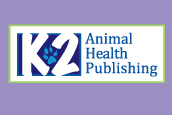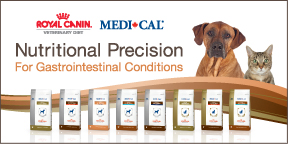
![]()

CE Quizzes Home | Pregnancy Quiz
Pregnancy for vet techs
SASKATOON, SK − “The right treatment when you are not pregnant is nearly always the right treatment when you are pregnant”, explained Kristine Mytopher, MD, FRCSC, speaking at the Saskatchewan Association of Veterinary Technologists (SAVT) Conference. While there are always risks involved in working in a veterinary hospital – physical, chemical, biologic, and stress – there are strategies to minimize them, so that working with animals is as safe as possible during pregnancy.
According to data from the College of Veterinarians of Ontario, 45% of 2,745 veterinarians, and 98% of the 1,100 veterinary technicians, are of childbearing age.
Environmental exposures and risk to fetus
In the general population, environmental exposures account for 4-6% of birth defects. This can be due to maternal illness, infection, physical agents (radiation or heat exposure), chemical agents, or drugs. The teratogenic effects depend on several factors, including inherited susceptibility, dose of agent, timing of exposure, and any concurrent exposures or illnesses. However, the cause of the vast majority of congenital malformations is unknown or multifactorial.
Radiologic imaging, nuclear medicine tests, and pregnancy
Concern about possible radiation exposure should not prevent medically necessary diagnostic procedures from being performed, stressed Dr. Mytopher. It is important to consider the gestational age, other available options, such as ultrasound or MRI, and abdominal shielding. There are no known significant fetal effects from exposure to diagnostic ultrasound or MRI involving a magnetic field at 1.5 Tesla or lower. Wearing a lead apron, maximizing the distance from the source, and minimizing the time of exposure are also important factors in reducing risk.
In some cases, a veterinary technician will be responsible for conducting nuclear medicine tests to assess a patient’s thyroid function. Dr. Mytopher said that while radioiodine isotopes are readily absorbed by the fetal thyroid by 10-12 weeks, there have been no reports of adverse fetal effects from diagnostic doses of radioactive iodine.
Chemical exposure
With regard to inhalaled anesthetic agents, most of the existing evidence in humans indicates no associations between occupational exposure and increased risk of birth defects or miscarriage.
There is no evidence of a link between significant exposure to pesticides in health care workers and an increased risk of birth defects. However, there has been some increased risk noted in women working in agricultural activities with pesticides. Dr. Mytopher added that the almost universal exposure to low levels of pesticides makes it difficult to determine effects.
Animal studies with solvents demonstrate limb and CNS defects, and skeletal malformations. A Motherisk Study involving 125 women who had been exposed to occupational solvents and 125 controls who were never exposed to solvents, demonstrated that exposure to organic solvents was associated with an increased risk of a history of miscarriage and an increased risk of major malformations. Prevention includes wearing personal protective equipment and appropriate ventilation.
Medications
Dr. Mytopher said that most antibiotics are safe in pregnancy, but tetracycline, streptomycin, erythromycin estolate, and the fluroquinolones are to be avoided. Analgesics are safe and of the anti-neoplastic agents methotrexate should be avoided. No significant association has been made between cytotoxic drugs and congenital malformations or stillbirths. However, small studies show that there may be an association between exposure to chemotherapy via handling and spontaneous abortions.
Dog and cat bites
The management of bites is similar to that for non-pregnant women and consists of wound inspection, meticulous wound care, and wound closure if necessary. If there is deemed to be a high risk of infection, prophylactic antibiotics are recommended, with clavulin recommended as a safe first line agent in pregnancy.
Rabies immunization prophylactic treatments are not known to cause any fetal abnormalities and it is believed that there is a higher risk to have untreated rabies than to be exposed to vaccine/immune globulin. For those exposed to the Borellia pathogen, there is no evidence of a congenital syndrome if treated. As well, there is no evidence for vertical/horizontal transmission. Treatment is the same for non-pregnant women with the exception of avoiding doxycycline.
Cytomegalovirus (CMV) is a DNA herpes virus and one of the most common viral infections in pregnancy, though usually asymptomatic in women. The disease can cause microcephaly, which can result in progressive hearing and/or visual loss and cognitive impairment. Preexisting maternal CMV seropositivity significantly decreases intrauterine transmission, suggesting a protective role of maternal immunity. The mortality associated with primary infection is estimated to be 5%, with long term neurologic sequelae at 50-60%. Non-primary infection occasionally results in symptomatic disease at birth but rarely death.
Dr. Mytopher explained that routine screening for CMV is not recommended because there is no vaccine available, and it is difficult to make a diagnosis between primary and nonprimary infection or to determine the timing of the infection, which could have occurred many months before conception. She added that although fetal infection can be detected, there is no way to accurately predict whether the fetus will develop significant sequelae. Disease prevention includes good personal hygiene, and using CMV negative blood products when transfusing seronegative women. Treatment consists of antivirals with or without intravenous immunoglobulin
Toxoplasmosis is a systemic illness caused by the protozoa toxoplasma gondii. Transmission is via ingestion of undercooked meat, unpasteurized milk, contaminated water, and exposure to feces of an infected cat. However, owning a cat has not been shown to be a risk factor, and transmission to humans via touching cats is virtually nonexistent. The incidence of maternal infection during pregnancy ranges from 1-8 per 1000 susceptible pregnancies; Dr. Mytopher added that there is no good evidence for routine screening. She did note that while immunocompetent women infected prior to conception virtually never transmit toxoplasmosis to the fetus, rare exceptions have been reported. The risk is higher as gestation advances, but there is greater severity with earlier transmission. Testing for the disease may involve maternal serology, amniocentesis with PCR, and ultrasound. There is no treatment proven to reduce transmission. Disease prevention includes avoiding of sources of infection, such as animal feces, and hand washing.
Q fever is a zoonotic infection caused by Coxiella burnetii. The most common sources of human infection are farm animals, cats, rabbits, pigeons, dogs, and the inhalation of contaminated aerosols from parturient fluids of infected livestock. The disease in humans presents as a self-limited flu-like illness, pneumonia, and hepatitis. In pregnant women it is associated with miscarriage, low birthweight, low amniotic fluid, preterm delivery, and stillbirth. It is not clear whether it is associated with a congenital syndrome. Systemic testing for Q fever should be performed during pregnancy in areas where Q fever is prevalent and when a pregnant woman has fever of unknown origin. Pregnant women are treated with cotrimoxazole (the usual treatment is tetracycline or doxycycline but these must be avoided in pregnancy).
Ideally, immunizations should be given prior to conception, otherwise they
should only be given if known to be safe, if the mother is at high risk of exposure,
or if infection is potentially hazardous to mother and/or fetus. Inactivated viral vaccines,
bacterial vaccines, and toxoids (e.g. Hep A/Hep B, menigococcus, rabies) are
considered to be safe in pregnancy
Dr. Mytopher concluded by saying that while there are risks to veterinary technicians
during pregnancy, there are strategies to minimize exposure, including wearing
personal protective equipment, monitoring exposure, avoiding known teratogens, and
ensuring that immunizations are up to date.



